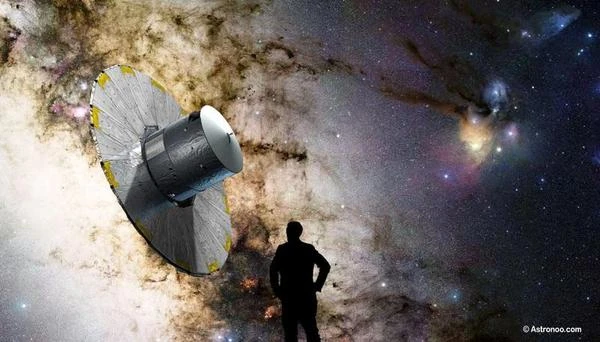
Image description: The GAIA satellite, built in Toulouse (France) by Astrium. In ancient Greece, in the 2nd century BC, Hipparchus of Nicaea (-190 to -120 BC) meticulously measured the position of more than a thousand stars with the naked eye. Hipparchus produced the first star catalog. Hipparcos (HIgh Precision PARallax COllecting Satellite), the first astrometry satellite (1989-1993), provided the celestial coordinates of some 120,000 stars, with a precision 10 to 100 times greater than previous catalogs, established using ground-based instruments. After the Hipparcos satellite, it is GAIA's turn, the surveyor, to survey the Galaxy with much larger mirrors, and to map more than a billion objects (stars, planets, pulsars, quasars, etc.) in 3D. Image source: astronoo.com
GAIA is a project of the European Space Agency (ESA). The satellite was launched on December 19, 2013, from French Guiana by a Soyuz rocket. This mission aims to map our Milky Way in 3D with a precision ranging from 7 microseconds of arc or 7/3600th of a degree for the brightest stars (magnitude 12 and less) to 300 microseconds of arc for the faintest stars (magnitude 20).
Scientists will collect data from more than a billion objects and better understand the mechanisms of galaxy formation, the internal workings of stars, the influence of dark matter, and the bending of light rays due to gravitational effects.
The 2-ton probe has 3 detectors installed on one of the two telescopes that can make about 75 measurements of astrometry, photometry, and spectroscopy on each observed object. It will record the position, speed, brightness, and distance from Earth of each star targeted by its telescopes.
GAIA is therefore the surveyor of the Galaxy; the probe will send more than one petabyte of data (1000 TB) over 5 years, which will be processed by CNES and 30 international laboratories. Thanks to the census of all these stars, astronomers will be able to identify different generations of stellar populations and reconstruct their trajectory in space and time.
The goal of GAIA is to produce the most detailed image possible of the structure of our Galaxy and predict its evolution. The surveys, of unparalleled precision, will feed scientists for decades. GAIA is capable of measuring the thickness of a hair located 1000 km away.
To measure the distance of stars, GAIA uses the stellar parallax method. This ancient geometric method involves sighting the star twice, at six-month intervals. In other words, astronomers measure the parallax angle by measuring the position of a star from one position on Earth's orbit and measure again, 6 months later, when Earth is on the other side of the Sun, having traveled 300 million km. The closer the star, the larger the parallax angle, which directly gives us the distance of the star. Knowing the distance of a star allows us to determine its main characteristics, its real luminosity, its age, its mass, its temperature. For this, it will be necessary to know at all times the distance between these two firing windows and therefore know very precisely the position of GAIA.
Continuous monitoring from the ground will be ensured by a network of telescopes to position GAIA to within one-hundredth of an arcsecond, meaning the satellite must remain confined within a radius of 100 meters. This device, called GBOT (Ground Based Optical Tracking), complements the ESA's radio methods.
In a small bubble of 12 light-years in diameter centered on the Sun, there are already 31 stars. But as soon as GAIA points its two silicon carbide telescopes towards distant distances, on the order of 30,000 light-years, it will be able to detect hundreds of thousands of stars and even exoplanets the size of Jupiter.
GAIA should detect 1000 to 2000 Cepheids in the Milky Way; as the distance will be perfectly known, this will allow the measurement method to be calibrated with precision. The European probe will also study nearly 500,000 quasars, and through the large-scale observation of the movement of stars, Gaia will show us the distribution of dark matter.
Perhaps its measurements will provide answers to one of the major problems of modern astrophysics, that of the nature of most of the matter in the universe. Thanks to the great precision of the probe, Gaia's scientific measurements will allow us to test even more finely the theory of general relativity of Einstein. It is likely that usually invisible gravitational effects will appear clearly in the data.
And finally, thanks to the precision of its photometric and astrometric measurements, Gaia will be able to see thousands of exoplanets by the transit method since each object must be seen several dozen times during the mission. The computing power required to process all this data is estimated at 6 teraflops (6,000 billion operations per second). The volume of data to be processed will be on the order of one million trillion bytes, or the capacity of 250,000 DVDs.
Gaia will observe the deep sky from a privileged orbit around the Sun. This special location is the Lagrange point L2. The L2 point is a privileged place to observe the universe because it is an extremely stable thermal environment. It is located 1,492 million km from Earth on the line defined by Earth and the Sun. Since 2009, the Planck Surveyor and Herschel satellites have been on this orbit. This Lagrange point L2 follows Earth as we orbit the Sun, so the Sun, Earth, and Moon are always out of the field of view of the instruments.
With the completion of its observations and the publication of the final catalog, Gaia will leave an unparalleled legacy for future generations of astronomers.